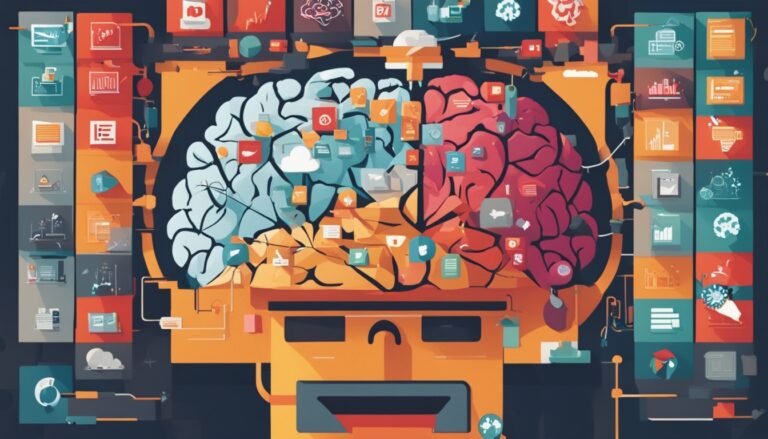The Future of Marketing: A Blend of Classic and Emerging Theories
Did you know that in the last 20 years, articles and research on ‘digital transformation’ grew from just 2 to 3,109? This shows a big change in marketing. Now, old marketing ideas mix with new digital ways to connect with customers. This mix uses personalized marketing and dynamic engagement across different platforms.
Marketing has changed a lot in the last century. It moved from simple ads to complex, tech-based strategies. As companies spend billions on digital tech, marketing must also change to use these new tools well. The future of marketing is about combining old wisdom with new tech to engage with customers in exciting ways.
Classic marketing ideas are still important, even with new methods coming up. Think of Philip Kotler’s ideas that have helped marketers for years. But, adding tech like AI, real-time data, and predictive analytics takes marketing to a new level. Marketers now have many tools to make experiences that really speak to today’s customers.
Key Takeaways
- The integration of classic marketing theories with emerging digital trends is reshaping the marketing landscape.
- Technological advances such as AI and predictive analytics offer new ways to create personalized marketing tactics.
- Industries are investing heavily in digital technologies, highlighting the need for adaptive marketing strategies.
- Capturing and utilizing real-time customer data is crucial for dynamic consumer engagement.
- Philip Kotler’s marketing principles remain foundational, even as they evolve alongside digital transformation.
Understanding Classic Marketing Theories and Their Evolution
Marketing has grown a lot since its start over a century ago. Early economists wrote the first marketing books. These books focused on advertising and how businesses could reach people.
As time went on, marketing became a more organized field. It moved from just selling things to planning and building relationships with customers.
The Origins of Marketing Management
In the early 1900s, marketing management started to form. Scholars saw the need for a planned approach to marketing. This led to new ideas in marketing textbooks.
These ideas included strategic planning and managing customer relationships. This change made marketing more analytical and focused on strategy.
Over time, new ideas in marketing came from fields like organizational behavior and consumer psychology. These ideas helped businesses understand consumers better and stay ahead in the market.
Legacy of Philip Kotler’s Marketing Concepts
Philip Kotler is known as the “Father of Modern Marketing.” His book, “Marketing Management: Analysis, Planning, and Control,” first came out in 1967. It’s now in its 15th edition, showing its lasting impact.
Kotler’s work blended different fields into his marketing ideas. He focused on putting the customer first and adapting to new digital trends.
Kotler also created key marketing models like the four Ps (Product, Price, Place, Promotion) and STP (Segmentation, Targeting, Positioning). These models help make marketing plans. He also stressed the need for a full customer experience, not just selling products.
Under Kotler’s guidance, marketing theory has changed a lot. “Marketing 1.0” was all about products. Then came “Marketing 2.0” and “Marketing 3.0,” which added emotional and human aspects. Now, “Marketing 4.0” deals with how technology is changing marketing today.
Impact of Digital Transformation on Marketing Strategies
The digital age has changed how we think about marketing. A study looked at 205 Italian companies and found big differences in how they use digital tools. Some companies saw a big boost in their marketing, while others didn’t use digital tools much.
This shows how important it is to keep up with digital marketing trends. It’s changing the way we market products.
The Shift from Traditional to Digital Marketing
Companies are moving from traditional to digital marketing fast. Traditional methods are still useful in some cases, but digital offers more interaction. Ted Moser, with 30 years of experience, says using technology is now a must.
This change is making marketers rethink old ideas. They need to use different skills to succeed.
Technological Advances and Their Influence
Technology has changed marketing a lot. Now, marketing teams use data to make smart choices and target customers better. Emanuela Conti, Furio Camillo, and Tonino Pencarelli found that digital changes affect everything a company does.
It’s made marketing more important for getting customers and making money. Marketing experts are looking at new ways to work. They’re using technology to connect with customers in new ways.
Also, digital changes help marketing drive sales and engagement. Experts like Moser say it’s key to blend tech with creativity in marketing. This way, companies can build strong relationships with customers, showing why staying up-to-date with digital trends is crucial.
The Rise of Content Marketing Strategies in the Digital Age
In today’s fast-changing digital world, content marketing has become key. Brands use content to build a strong brand-customer connection beyond old-school ads. They use digital tools to target people based on who they are and what they like, making them more likely to engage.
Creating Value Through Content
Content marketing is all about sharing valuable info, not just selling products. This approach has changed how people see brands, making them more loyal and coming back for more. Thanks to digital tools, companies can quickly see how well their content is doing and make it better.
Storytelling and Brand Engagement
Storytelling is key to connecting with customers. Brands like Nike and Coca-Cola tell stories that show off what they stand for. These stories create a deep brand-customer connection, keeping the brand in people’s minds. In a world where digital is everything, telling a good story can make a brand stand out.
As new media grows, it makes marketing cheaper and more effective. Digital tools let brands target people well and track how well their content works. This helps them make smart choices for the future.
Influencer Marketing Campaigns and Their Growing Importance
In today’s fast-changing marketing world, influencer marketing is key for brands to connect with people in a real way. The influencer marketing growth has changed how companies reach out to customers. They now use personal recommendations from influencers to influence buying habits.
Leveraging Social Proof
Social proof in marketing is a big reason why influencer marketing works. When influencers talk about a product, it feels more personal to their followers. This builds trust and credibility. For example, Dunkin Donuts saw a 20% increase in cold brew sales the day “The Charli” drink was introduced, thanks to an influencer.
Also, a Media Trends report found that 94% of marketers think influencer marketing is effective. Influencers give real testimonials that are more convincing than old-school ads. These ads now get only 0.47% of clicks.
The Role of Micro-Influencers
Micro-influencers have become a big part of influencer marketing growth. They may not have as many followers as big influencers, but they connect more deeply with their audience. This micro-influencer impact creates a stronger community feeling and higher engagement. Research shows that working with micro-influencers can bring up to 11 times the return on investment compared to traditional ads.
Brands use micro-influencers to reach specific markets in a real way. This approach is seen as trustworthy by the audience. Today, people are wary of influencer ads, so being real is key. The trust people have in influencers greatly affects what they decide to buy, showing how important trust and credibility are in influencer marketing.
Data-Driven Marketing Approaches to Enhance Decision Making
Modern marketing uses a strong mix of technology and analytics. Data-driven strategies are key to making campaigns better and more effective.
Predictive analytics in marketing is crucial for knowing what customers will do next and what trends will happen. By looking at customer data, surveys, and A/B tests, marketers can find important insights. These insights help shape their strategies.
Brands use statistical tools to understand these insights. This way, they can make campaigns that speak directly to customers. This improves how they make decisions.
Predictive Analytics in Marketing
Predictive analytics has changed how businesses plan their strategies. It uses advanced machine learning and statistical models to predict trends and behaviors. This lets marketers make changes before they happen, making campaigns more efficient and targeted.
- Using customer data to predict what they’ll buy.
- Looking at survey data to understand customers better.
- Testing A/B to improve campaign results.
Customer Insights and Behavioral Analysis
To stay ahead, businesses need to understand what customers do and like. By deeply analyzing customer actions and tastes, marketers can make strategies that hit the mark. Tools like eye-tracking and neural predictors help understand how customers make decisions.
Using customer insights in data-driven strategies helps brands create more relevant and engaging experiences. This leads to better growth and loyalty from customers.
AI-Powered Marketing Automation for Efficiency and Personalization
Artificial Intelligence (AI) is changing the way we market with AI marketing automation. It makes things more efficient and helps give customers unique experiences. Already, 51% of marketers use AI, showing how popular it has become.
Using AI marketing automation helps businesses work better. It cuts down on manual work and makes marketing more efficient. Now, tasks that used to take a lot of time are automated. This lets marketers focus on things that help the business grow.
AI marketing automation also makes customer experiences more personal. Brands can send content and messages that really speak to each customer. For example, Netflix uses AI to suggest movies that fit what you like, showing how AI can build strong connections with people.
AI is not just effective; it’s getting more popular, especially in B2B marketing. It’s catching up in B2B, with uses like predicting what buyers will do and setting the right prices.
With AI marketing automation, businesses can find new opportunities in big data. This is key for making smart decisions in fast-changing markets where what customers want keeps changing.
But moving to AI marketing isn’t easy. There are issues with technology and making sure automation works right. Also, AI is great at looking at past data but can struggle with new, unexpected situations.
Even with these hurdles, the benefits of AI marketing automation are huge. It gives businesses an edge with better marketing efficiency and more personalized customer experiences. As more companies use AI, its impact on marketing will only grow. It will change how brands talk to their customers in the future.
Creating Omnichannel Customer Experiences
Today, combining online and offline touchpoints is key in omnichannel marketing strategies. Brands like Best Buy and Warby Parker show us that having both an online and physical presence is crucial. They know how to make a smooth integrated customer journey by using every touchpoint. This approach makes sure customers have a unified experience that really speaks to them.
Integrating Online and Offline Touchpoints
The U.S. retail economy is huge, worth $3 trillion and supporting one in four jobs. But for stores like Thule and Warby Parker, just having a website or a store isn’t enough. They’re mixing digital technologies and in-store experiences to meet what customers want. For example, Best Buy sends 50% of its online orders from local stores, making sure online and offline sales work together smoothly.
Retailers are coming up with new ways to connect the digital and physical worlds. A study by Saghiri, Wilding, Mena, and Bourlakis (2017) suggests how to link processes and tech for omnichannel systems. With insights from Piotrowicz and Cuthbertson (2014), they can make omnichannel customer experiences seamless.
Ensuring Consistent Brand Messaging
For omnichannel marketing strategies to work, it’s vital to keep the brand message the same everywhere. Whether it’s through a website, a store visit, or social media, the brand should stay consistent. Hansen and Sia (2015) found that making customer experiences smooth across both online and offline is tough but key to success.
Warby Parker shows how to do this well. They opened a store in Grand Central terminal in New York City, showing their brand everywhere. This approach builds customer loyalty and creates a strong bond with the brand. It makes for a powerful integrated customer journey.
Interactive and Immersive Marketing Technologies
Virtual and augmented reality are changing how brands talk to customers. These new technologies let companies make marketing experiences that are both interactive and personal. This mix helps brands grow and keeps customers coming back with engaging experiences.
Virtual and Augmented Reality
Virtual reality marketing has changed how we connect with people, making experiences that grab attention. In 2020, VR and AR were expected to bring in a huge 29.5 billion dollars. The retail industry is putting more money into AR and VR, expecting it to grow a lot.
Also, 71% of shoppers said they’d visit a store more if it had AR experiences. This shows how big a role AR can play in making customers loyal and boosting sales.
Gamification and Customer Engagement
Gamification makes marketing fun and competitive, which gets customers more involved. Campaigns that feel like games make people care more about the brand. AR experiences keep people’s attention for 75 seconds, way more than old ads.
Using these new tools, companies can make customer experiences that really stand out. By using virtual reality and gamification, brands can make a big impact. This helps them connect better with customers and succeed over time.
Conclusion
The marketing world has changed a lot, blending old ideas with new digital ways. It started with ancient trading routes and grew with the American Marketing Association in 1936. Since then, it has seen many changes, like the rise of branded goods and new marketing areas.
Now, the move to digital has changed everything, thanks to tech and big data. Tools like predictive analytics and AI are changing how companies talk to customers. This mix of old and new helps brands give unique, real experiences, keeping customers loyal and growing.
Looking ahead, we see big changes like virtual and augmented reality changing how we connect with brands. The push for sustainable marketing, especially in fashion, shows we must think about the planet. By using many channels and understanding customers well, companies can thrive in this new world.
The future of marketing is all about being innovative, personal, and true to your brand. These values will guide marketers as they face new challenges and opportunities.
Source Links
- How digital technologies reshape marketing: evidence from a qualitative investigation – Italian Journal of Marketing
- The impact of marketing strategies in healthcare systems
- The role of self-determination theory in marketing science: An integrative review and agenda for research
- An Interview with Philip Kotler, the “Father of Modern Marketing”
- evolution of marketing [theory] | The Marketing Concept
- History of marketing
- The impact of digitalization on marketing activities in manufacturing companies
- The changing role of marketing: transformed propositions, processes and partnerships
- From Traditional to Digital: Exploring the Shift in Marketing Strategies
- Traditional Media vs New Media
- Writing a marketing strategy and plan
- Influencer Marketing
- Be constantly different! How to manage influencer authenticity – Electronic Commerce Research
- Influencer Marketing: Growth Strategies + Connecting Options
- Undergraduate Program Course Descriptions
- Data Science and Analytics: An Overview from Data-Driven Smart Computing, Decision-Making and Applications Perspective
- Implementing Artificial Intelligence in Traditional B2B Marketing Practices: An Activity Theory Perspective
- A strategic framework for artificial intelligence in marketing – Journal of the Academy of Marketing Science
- The Future is Omni: A Retail Exploration
- A SYSTEMATIC REVIEW AND QUANTITATIVE CONTENT ANALYSIS
- Virtual Reality in Marketing: A Framework, Review, and Research Agenda
- The Metaverse: from Marketing to Mind Control – Future of Marketing Institute
- New Areas of Research in Marketing Strategy, Consumer Behavior, and Marketing Analytics: The Future is Bright – Jagdish Sheth
- Marketing Sustainable Fashion: Trends and Future Directions
- Layout 1







